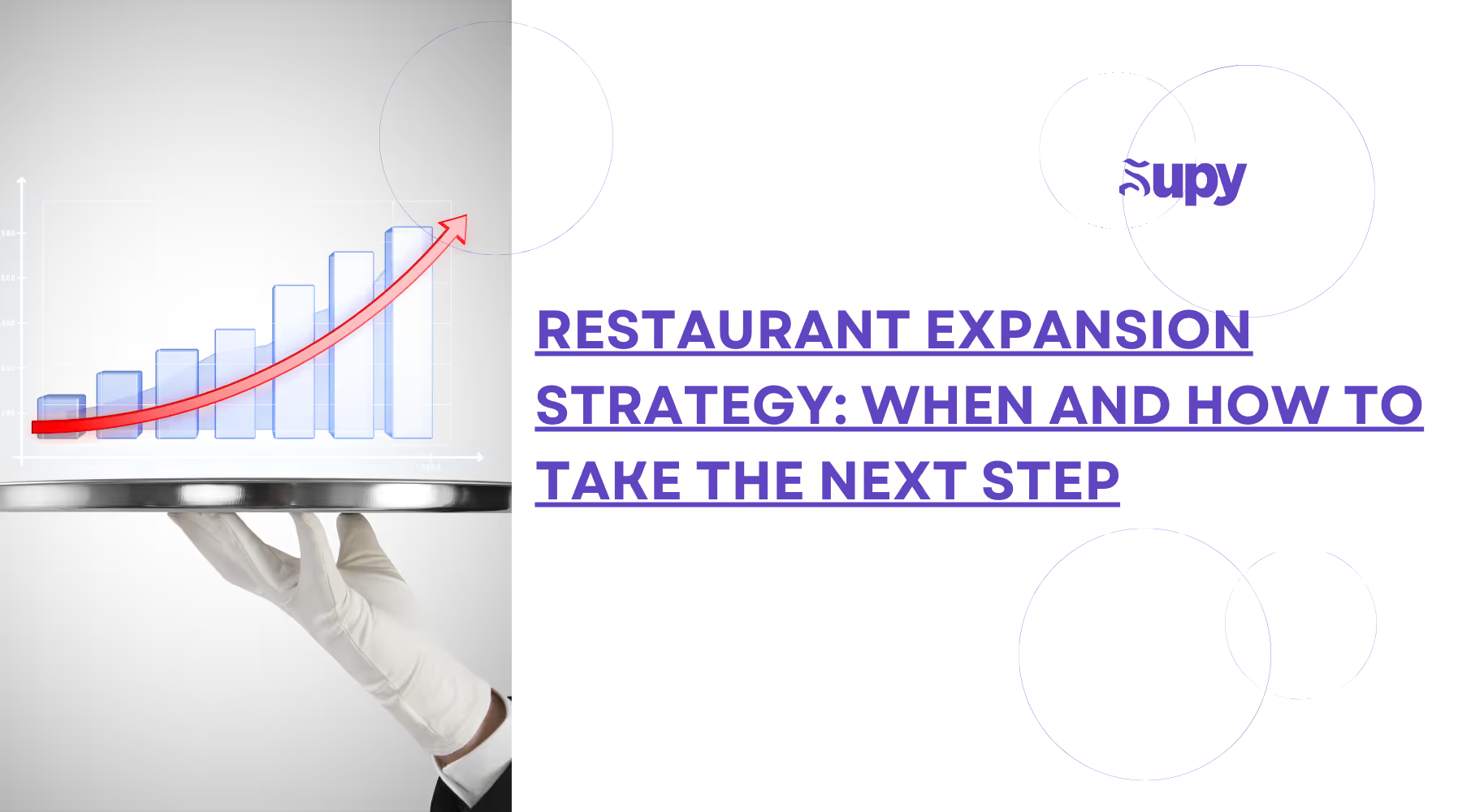22 Restaurant Marketing Strategies In 2025
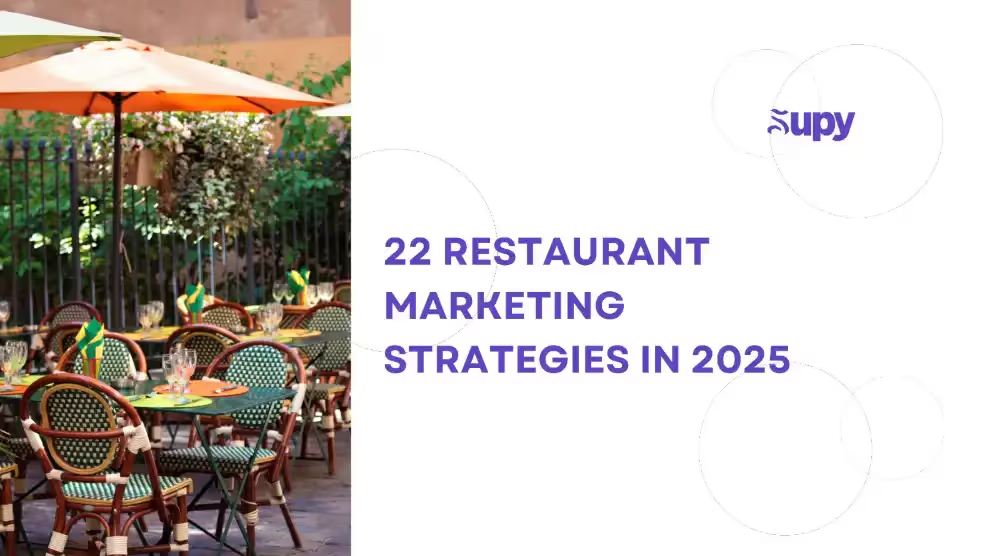
Introduction
The restaurant business is more competitive than ever, which is why restaurants must find innovative ways to differentiate themselves amongst the crowd. Restaurant Marketing has become a significant part of a restaurant business’s operations, and with an increasing number of consumers ordering online, nailing your restaurant marketing strategy is key to gaining new customers and ensuring that your regular ones keep coming back.
This article covers the restaurant marketing strategies you need to know about to succeed. We’ll cover the different restaurant marketing tactics adapted to every type of goal, type of restaurant, and type of audience.
Table Of Contents
- Build A Strong Brand Identity
- Build A Website
- Take Great Pictures
- Optimize Your Online Menu
- Be On Google Maps
- Get On Delivery Apps
- Create Your Own App
- Use Restaurant Reservation Apps
- Be On Social Media
- Boost Your Following With A Contest or Giveaway
- Leverage User Generated Content & Influencers
- Use Email Marketing
- Send Special Offers For A Customer’s Birthday !
- Celebrate Special Days
- Create A Loyalty Program
- Advertise Through Wifi Marketing
- Advertise Through SMS Marketing
- Appear In Food Truck Events
- Send Direct Mail
- Invest In Press
- Push Ads Locally
- Give Back To The Community
- Conclusion
- About Supy
Introduction
The restaurant business is more competitive than ever, which is why restaurants must find innovative ways to differentiate themselves amongst the crowd. Restaurant Marketing has become a significant part of a restaurant business’s operations, and with an increasing number of consumers ordering online, nailing your restaurant marketing strategy is key to gaining new customers and ensuring that your regular ones keep coming back.
This article covers the restaurant marketing strategies you need to know about to succeed. We’ll cover the different restaurant marketing tactics adapted to every type of goal, type of restaurant, and type of audience.
Table Of Contents
- Build A Strong Brand Identity
- Build A Website
- Take Great Pictures
- Optimize Your Online Menu
- Be On Google Maps
- Get On Delivery Apps
- Create Your Own App
- Leverage Chatbot Marketing
- Be On Social Media
- Boost Your Following With A Contest or Giveaway
- Leverage User Generated Content & Influencers
- Use Email Marketing
- Send Special Offers For A Customer’s Birthday !
- Celebrate Special Days
- Create A Loyalty Program
- Embrace Augmented Reality (AR) Experiences
- Advertise Through SMS Marketing
- Host Virtual Cooking Classes
- Collaborate with Micro-Influencers
- Focus on Sustainability and Eco-Friendly Practices
- Push Ads Locally
- Give Back To The Community
- Conclusion
- About Supy
1. Build A Strong Brand Identity
Building a brand that makes you memorable and easily recognized is one of the most important steps in your restaurant marketing strategy. From your name to your logo, and from your colors to the look and feel of your restaurant, every detail counts when it comes to building a restaurant brand.
This starts with having a clear understanding of what you want your restaurant to be, beyond “just” serving food. What is your mission? Who do you want to serve? Is your restaurant designed to bring families together to have a good time, or are you aiming more towards college students looking for a good daily deal for their daily lunch?Then, choose your color scheme.
- You could go with personal preferences, and go with what you believe would be common sense : For example, think of earth colors - such as brown, dark green, deep red, deep orange, as your starting pattern if you operate healthy food restaurants.
You could also dig into the psychology of colors to promote a certain type of consumer behavior : Bright Red is typically used in fast food types of restaurants, as Red is known to increase guests’ heart rates and make them hungry. It also promotes fast eating, which means a higher table turnover rate.
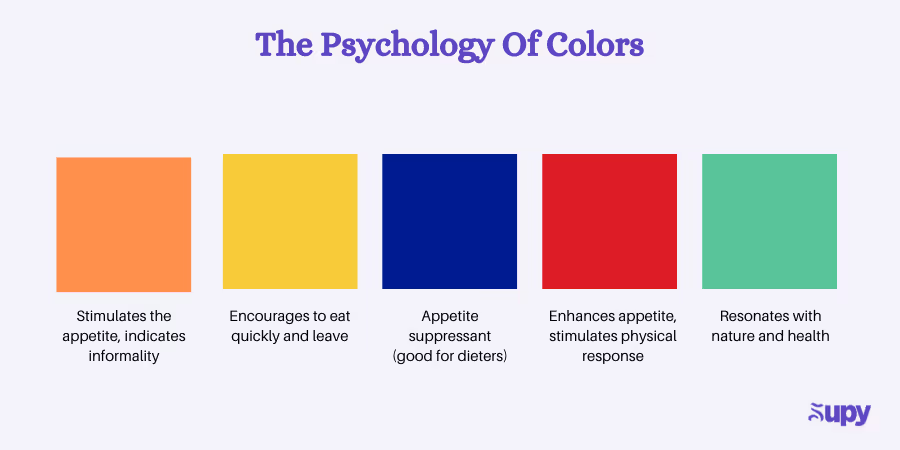
Time to choose a name and a logo! You could either choose a name that is in line with your business, such as “Rachel’s Vegan Kitchen”, or a name that you think sounds nice. You can use popular free logo maker, such as Looka.com to create one.
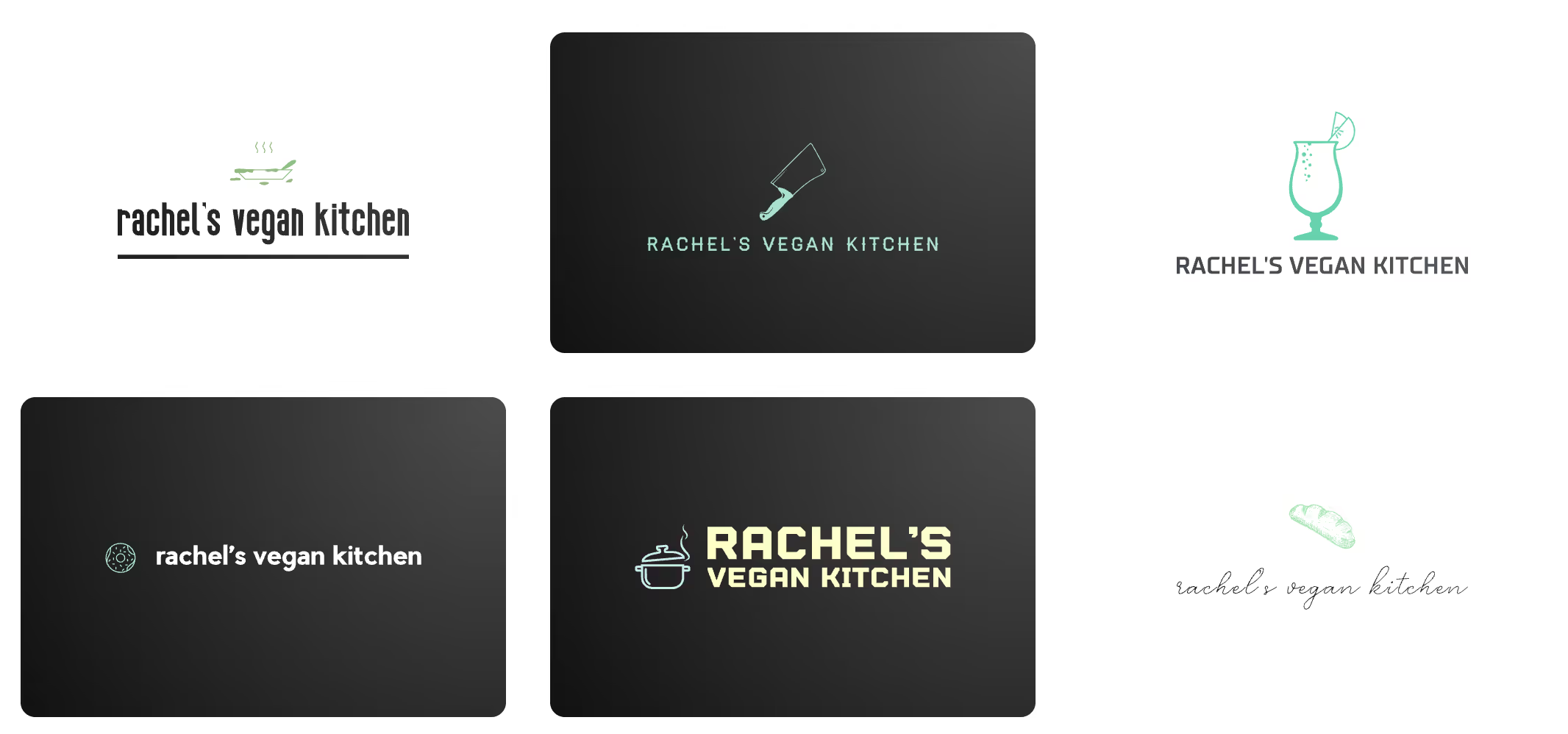
Once you’ve built a solid brand identity, make sure that the rest of your assets adopt the same tone of voice, color scheme, and look and feel - from your menu to your ads and social media pages.
Keep in mind, having a memorable brand is not limited to just colors and fonts!
Building a great customer experience, and promoting word of mouth, is one of the best ways you can market your business.
https://www.youtube.com/watch?v=j0EI5IFDrcU
2. Build A Website
It is common behavior to check a restaurant’s website and menu before deciding to pay it a visit, or ordering from it. This is why having a clean, clear, easy to navigate website is important. By not being online, restaurant owners lose reach and exposure, meaning they lose potential business.
Also, with mobile phones becoming the primary device for searching the internet, make sure your website is performant - meaning it loads quickly - and is mobile-friendly.
Here’s how you could build your own website with little resources :
1- Start with research : look at the websites of restaurants similar to your type, and see if you find any interesting ideas! These can be related to the navigation and the look and feel.
2- Choose a code-free website builder, such as Wix.com or Squarespace.com. These platforms help you get a website going without any code, nor professional design. You can get a head start by using one of their pre-existing templates and customizing it.

3- Look for technological partners, such as reservation software, if you would like to integrate those, and make sure that they have an integration with the website host you’ll be opting for (wix, wordpress, or others).
4- Upload your assets, such as menu, pictures, an About Us page, locations, and contact info.
5- Click on publish and start receiving calls and bookings !
3. Take Great Photos
With social media being a daily activity in most people’s life, it is key to attract the users’ attention with captivating pictures.
Although every restaurant will have its own way of showcasing their dishes and marketing themselves, some rules should be followed :
- Avoid flash! Try to capture your dishes with a soft light that still showcases the details of your item.
- Every detail matters : ensure that your cutlery, table cloths, plating, are on point : no dirt, dust, finger prints, or crease should be seen.
- Choose fresh ingredients : Choose parsley that looks fresh and not closing on itself. Avoid using vegetables that are wrinkly. Think about what the customer would like to see when looking at a picture of a salad for example : fresh lettuce with drops of water, which showcases freshness and cleanliness.
- Keep the main focus on your dish. If there’s a lot going on in the background, either change the setting, or try to dim it down : reduce background light before shooting, or during editing. For daylight shoots, you can blur the background slightly.
- Add decorative garnish : beautify your dish by adding decoration elements, such as droplets of sauce, garnish, herbs, and such.
- Experiment with your photography : each dish will have a good angle. Pizza can look good on the side with a slice being pulled out, while a sandwich might look better with a close up, showing the sandwich’s content.
When styling your dishes, you should also make sure that your dishes are “instagrammable”. It is key to adapt to the behavior of your guests, and with many being on social platforms and now taking a picture of their meal to remember their experience, it’s important to have dishes that stand out without much effort necessary from your customers.
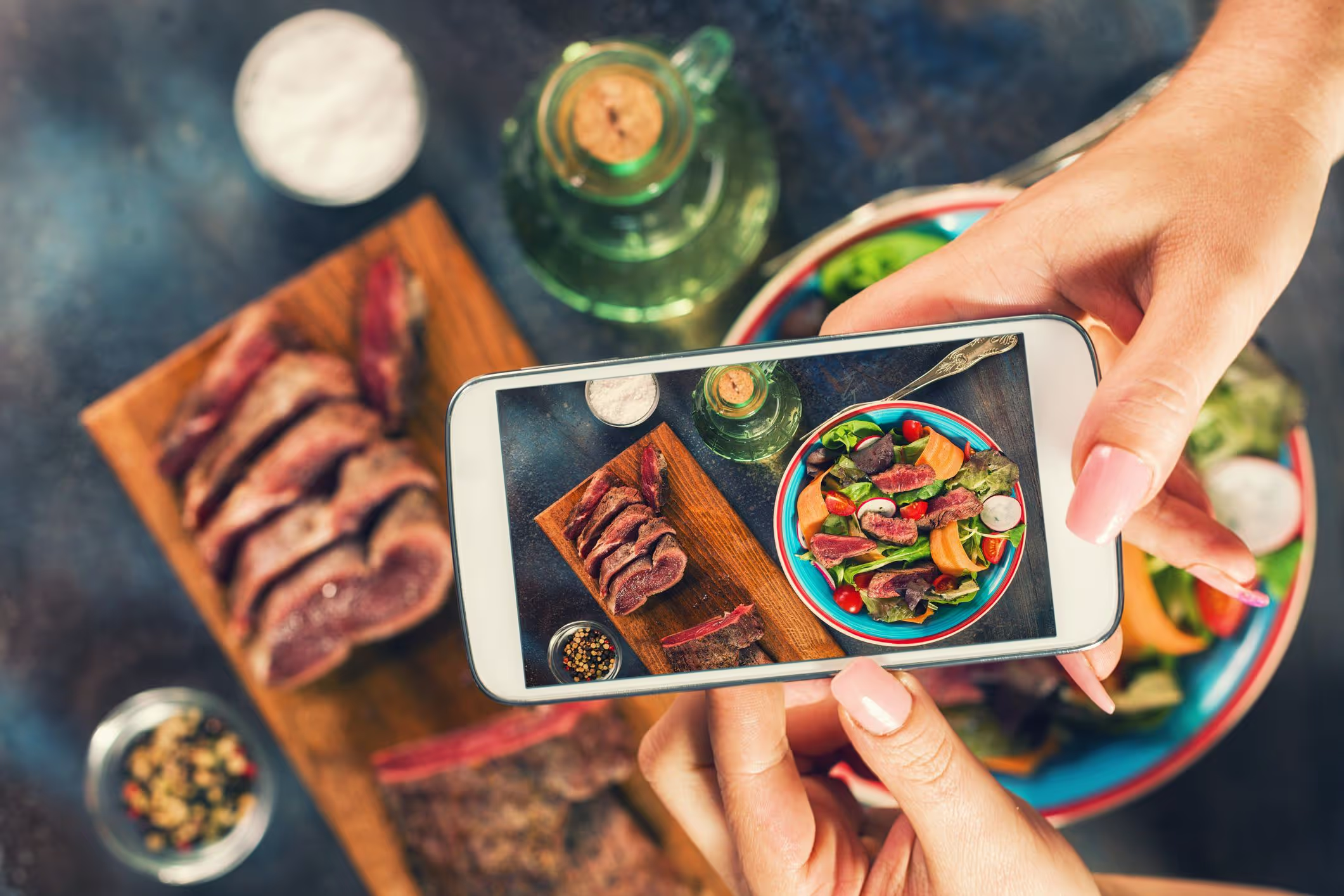
4. Optimize Your Online Menu
With a majority of customers looking at a restaurant’s menu before ordering or visiting your branch, it is key to create a menu that is clear, appetizing, and easily accessible from your website.

Recommended Reading
Menu Engineering : Key Steps To Build A Profitable Menu
You should, however, keep a few things in mind :
- Depending on the type of restaurant you operate, you may offer several menus : Lunch, Brunch, Dinner, and Weekend. It is key that the customer understands when and where each menu applies, in order not to disappoint. Set create descriptions, including the days and hours during which each menu applies.
- Optimize your menu for increased sales : Numerous tactics can be used to build a menu that performs. From the way you describe your dishes, to how you place your prices, every small detail can have an impact on your sales, and therefore profits. Do not underestimate this.
- Consider having a PDF and on-site menu : with Google needing to crawl your website, you may need to be aware that a PDF file cannot be read by Google. If your restaurant is known for a specialty dish (for example, Chili’s Molten Chocolate Cake), you may want to either have that item on a on-site menu, or improve your website to have those keywords in for your website to be found.
5. Be On Google Maps
Consumers often look for places near them, or for highly rated places they’d like to discover during the weekend. This is where being on Google Maps comes into play.

Add pictures, ask customers for reviews, and be responsive to reviews to showcase customer service.
Don’t ignore negative reviews, as these could be a chance to receive feedback, buy back a customer by addressing their negative experience and proposing to make it up to them, or simply call out a bad-intentioned person! Overall, responding to reviews, good and bad, will showcase a strong sense of customer service, will expand your reach, and give you a chance to acquire more customers.
Don’t forget to add your opening business hours, and update your status during holidays. Add a clear description that both helps customers understand what you do, but also helps you set yourself apart.
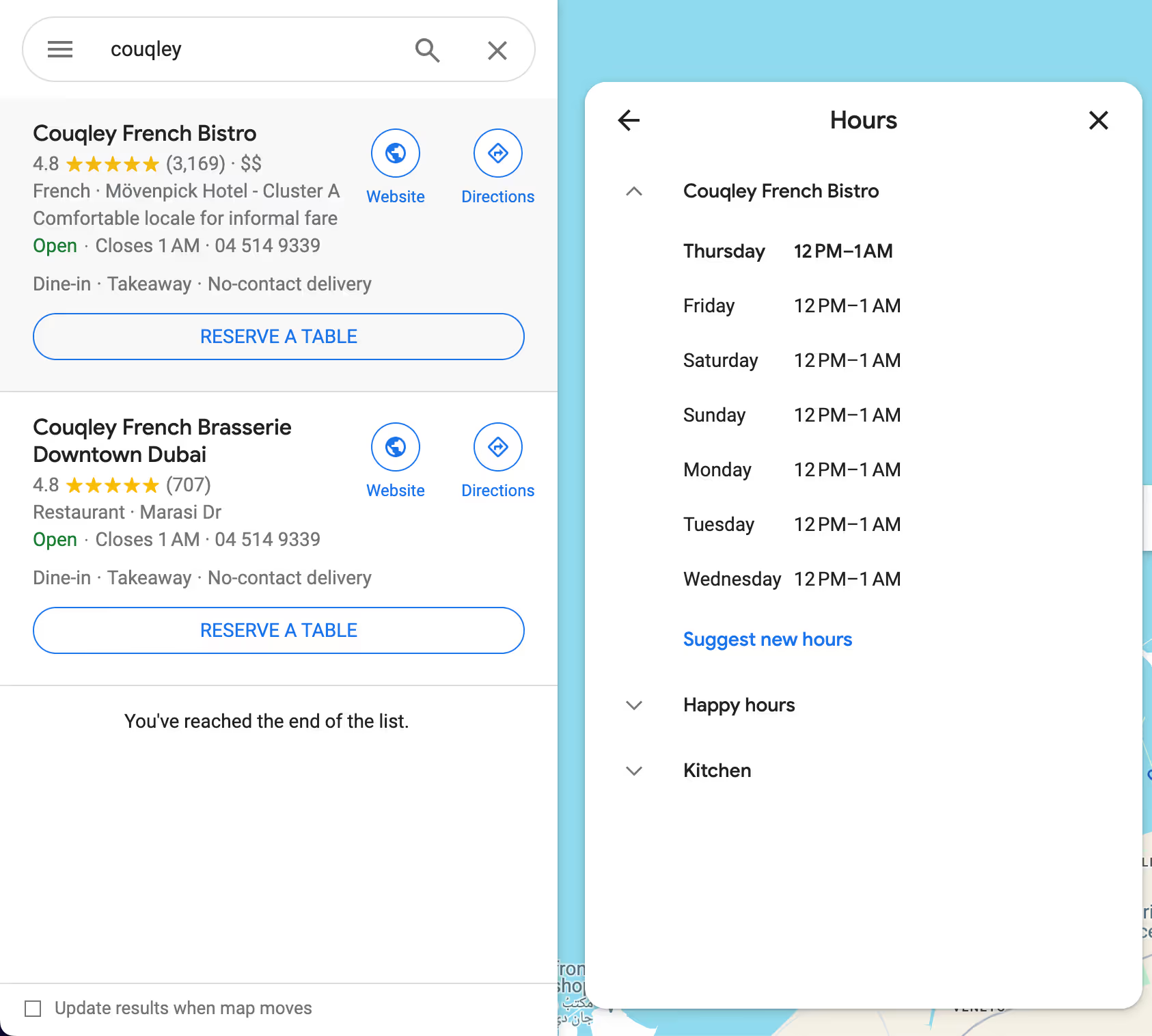
6. Get On Delivery Apps
With more consumers ordering online than ever, and the food delivery market surging to hundreds of billions ($221 billion in 2022 in the US alone), being present - and promoting - your business in delivery apps is crucial.

Within these delivery apps, you have the ability to run promotions or advertisements in order to capture a wider audience. Delivery apps work independently on acquiring new customers to join their platform. It is then your turn to convert these customers into your customers.
Keep in mind that your pricing strategy may need to be reviewed when selling on delivery apps. Keep in mind that the platforms take a commission for every dish sold.
7. Create Your Own App
Having your own app would enable you to create your own world, and talk to customers through your brand, in a way that suits you. Having an app enables you to also publicize your business on App Platforms such as Google Play or Apple App Store, thus increasing your reach. An app also enables you to track information on your users, such as their preferences when ordering online. This allows you to then personalize the content you push towards them, such as special discounts on their favorite dish.

8. Leverage Chatbot Marketing
The way customers interact with businesses is evolving, and chatbots are at the forefront of this transformation. Chatbots on social media and websites allow restaurants to engage with customers in real-time, providing instant answers to common queries, suggesting menu items, and promoting deals.
For example, imagine a customer visiting your website late at night, curious about your menu or hours of operation. Instead of leaving their question unanswered, a chatbot can engage with them immediately, ensuring they don’t leave without the information they need. This approach not only enhances the customer experience but also reduces the burden on your staff by automating repetitive tasks.
Chatbots can also collect valuable data about customer preferences, enabling you to personalize future marketing efforts. They make communication seamless, reduce response times, and help convert curious visitors into loyal diners.
9. Be On Social Media
Social media should be a key channel to have in your marketing strategy. A lot of a restaurant’s marketing strategy revolves around raising awareness about their business and acquiring new customers through pictures and videos of their dishes, events, behind the scenes, and more.
The power of social media revolves around the potential for virality and reach. Burger28 is an example of a restaurant whose social media presence exploded through their informative and appetizing videos.
View this post on Instagram A post shared by Supy (@supy.io)

Although each restaurant will have its own way of showcasing their dish and communicating their identity through social media, there are a few rules that you should abide by to maximize your chances of being found :
- Post on a regular basis : social media algorithms reward accounts that are constantly active. Your customers also need to have you at the top of their mind, which is why it is recommended to post about 2 or 3 times a week.
- Use high-quality images : social media platforms are all about visuals. For each channel that you decide to be active on, you must look into the ideal shooting settings for optimum upload quality.
- Don’t forget hashtags to help the algorithm categorize your post, and help customers interested in certain topics find you.
It is also key to be in touch with your customers on these platforms. If they have questions regarding your menu or locations, answer them ! If you’re trying a new dish, or are revamping your menu, take their advice !
10. Boost Your Following With A Contest or Giveaway
A great way to boost your following on social platforms is to promote a contest or giveaway, such as a free diner for 2, free merchandise, or simply a gift card !
Typically, restaurant owners will ask for their existing followers to follow their account, comment on a post, tag 3 friends, and share the post. The winner is then picked amongst the list of people who have participated. This gives you a chance to boost your following, increase your brand awareness, and reward one lucky winner !
11. Leverage User Generated Content & Influencers
Your customers can be a source of great content. Look into the pictures that you’re tagged in on social platforms, and see which angles of your restaurant are being photographed the most. This will give you insight into what your customers love most about your place. This also applies to your dishes. Try to use these insights to enhance your menu, design, and space.
If a customer tags you in a post or story (on instagram), reshare it for your other customers to see. Seeing other customers post about your business influences the decision of other customers. In fact, 79% of people say that user generated content influences their decision.
You should also think about inviting food influencers over, in exchange for a free meal. They will be taking pictures of your place and sharing it with their own audiences. You’ll need to be careful in choosing influencers that you think are aligned with the type of customers you’d like to see entering your restaurants. To find the best food influencers to work with, follow these steps :
- Do your research in terms of the best food influencers in your region. Follow their pages, see what type of content they post, and what type of audience follows them. Do you enjoy their content, and would you trust them in filming your location in an essence that you think is representative of your brand? Make sure their values and brand also stand with yours, as the best type of content is one that feels organic, rather than “bought”.
- Reach out to the influencers that you would enjoy working with, and whose impact you believe in. Reach out with a proposal, such as coming to have a meal for free, in exchange for a post.
- You can also organize a private event specifically for influencers.
12. Email Marketing
Email Marketing is one of the most efficient ways to market your business. In fact, 59% of people say that an email can influence where they decide to eat.
Sending emails isn’t as scary as it sounds, however, there are several steps you should follow in order to avoid going into spam, or having your spam score be incredibly high.
- Opt for an email address, and warm it up. Email warm up tools, such as instantly.ai, helps you build sending volume. If you were to send hundreds or thousands of emails from day 1, you may be flagged as a spamming entity. This is why it is key to start with a small volume, and build from there.
- Opt for an email marketing tool. Gmail is not a tool to use for mass sending. Opt for tools such as MailChimp, Sendinblue, or SendGrid, which’s sending platforms are not only aware that their customers need to send thousands of emails at once, but also give you the email design tools you need to build beautiful newsletters.
- Start building your subscriber’s list : set up a pop up on your website and offer a significant discount to the next order, if they sign up to your newsletter, for example. You can also add a QR code to your leaflets or menu, to advertise it.
- Start sending out emails ! This applies to special offers, events, updates on a new location… the sky’s the limit !
13. Send Special Offers For A Customer’s Birthday !
If you have your customers’ birthday registered in your CRM, this can be a great opportunity for you to build an emotional connection with them. Send them a personalized email offering them a discount for their birthday. You could send them such a message weeks in advance, in order to give them sufficient time to organize themselves and decide what options are available to them and their party.
14. Celebrate Special Days
From Christmas to New Year’s Eve, to Easter and Valentine’s Day, advertise special deals for these special days. Numerous customers are looking for a special place to spend these special days with their loved ones. These days are also a chance for you to charge a premium, without much resistance from customers. The offer you propose, however, must be up to their expectations.
15. Create A Loyalty Program
Rewards customers who keep coming back ! Given that it is much cheaper to attract a regular customer than a new one, you should try your best not to lose your existing customers. Regular clients contribute significantly to your bottom line, and putting in a loyalty program can actually increase your sales by 30%.
A loyalty program can look like something as simple as a loyalty card, whereby a customer gets a discount or a free drink every 10 orders. This not only incentises them to spend more often, but it also strengthens your relationship with them, as they will feel like a valued customer.
16. Embrace Augmented Reality (AR) Experiences
Augmented Reality (AR) is transforming how restaurants engage with their customers by creating immersive and interactive dining experiences. AR can showcase your menu in 3D, allowing customers to visualize dishes in real-time before ordering. This not only enhances decision-making but also sparks curiosity and excitement about your offerings.
For example, you can use AR to provide virtual tours of your dining space, highlight special promotions, or present behind-the-scenes looks at how your dishes are crafted. Some restaurants have even used AR to provide interactive wine pairings or showcase the origin stories of their ingredients.
By embracing AR, you can elevate your customer experience, differentiate your restaurant from competitors, and create a modern, tech-forward impression that attracts curious and digitally savvy diners.

There are plenty of WiFi marketing providers, such as Social Wifi, who provide you with the tools you need to measure the efficiency of your wifi marketing campaigns. Typically, these tools include a campaign manager and reporting features.
17. Advertise Through SMS Marketing
Every channel will have a different impact, depending on the region and audience you’re serving. Text Messaging, however, has proven to be a highly effective one, and the best way to get in touch with your customers. SMS Marketing helps you build awareness, promote offers, and avoid getting sent to Spam.
Several steps should be followed to make it work :
- Ensure your customers have agreed to be marketed to, through an opt-in process. Their number can be collected from several sources, namely from directly opting for promotions, or through their Wifi sign up process.
- Add clear calls to action, such as “Order Now” or “Book Now”
- Write with efficiency in mind : SMS is made for short texts. Be straight to the point and try to showcase the value of your message (event, offers…) as soon as possible, within the first few words.
18. Host Virtual Cooking Classes
With more people seeking engaging online experiences, virtual cooking classes are an excellent way to connect with your audience and showcase your culinary expertise. These classes allow your restaurant to go beyond just serving meals and position itself as a community-driven brand that shares its knowledge and passion for food.
For instance, you could host a live-streamed session teaching customers how to make one of your signature dishes. This not only builds excitement around your menu but also creates a personal connection with your audience. Participants are likely to visit your restaurant to taste the dish made by professionals or to try more items from your menu.
Virtual cooking classes can also help you reach a broader audience, as people can join from anywhere. It’s a great way to build a loyal community while simultaneously promoting your restaurant.

19. Collaborate with Micro-Influencers
Micro-influencers are redefining the marketing landscape with their ability to connect with highly engaged, niche audiences. Unlike larger influencers, micro-influencers often have a closer relationship with their followers, making their recommendations more genuine and impactful.
For example, partnering with a local food blogger or social media personality who frequently explores restaurants in your area can help you reach potential customers who trust the influencer’s opinions. These collaborations can include posts, reviews, or even content featuring your restaurant.
Micro-influencers often deliver better engagement rates and are more affordable, making them an excellent choice for restaurants looking to maximize their marketing budget. This strategy helps you build awareness while maintaining authenticity in your marketing efforts.
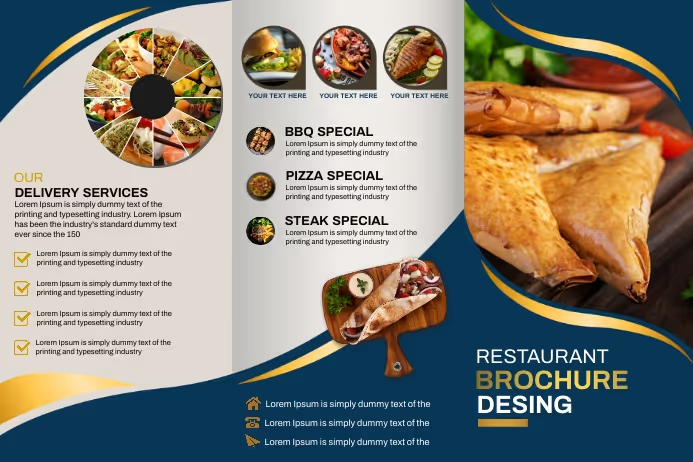
For example, partnering with a local food blogger or social media personality who frequently explores restaurants in your area can help you reach potential customers who trust the influencer’s opinions. These collaborations can include posts, reviews, or even content featuring your restaurant.
Micro-influencers often deliver better engagement rates and are more affordable, making them an excellent choice for restaurants looking to maximize their marketing budget. This strategy helps you build awareness while maintaining authenticity in your marketing efforts.
20. Focus on Sustainability and Eco-Friendly Practices
In today’s world, diners are increasingly mindful of the environmental impact of their choices. By adopting and promoting eco-friendly practices, your restaurant can appeal to this growing demographic of eco-conscious customers.
Highlight your efforts to use sustainable packaging, source ingredients locally, and reduce food waste in your marketing campaigns. For example, you could share behind-the-scenes content showcasing your commitment to the environment, such as how you compost food scraps or collaborate with local farmers.
These practices not only make your restaurant more attractive to customers who value sustainability but also help you differentiate yourself in a crowded market. Showing that you care about the planet can strengthen your brand image and build loyalty among your audience.
21. Push Ads Locally !
Paid ads are an easy and great way to capture customers, especially locally. Google offers an easy-to-use ad platform with several options at your disposal, from Paid Search (so that people typing “Burger” find your link first), to being ranking you at the top of the page on searches done on Google Maps.
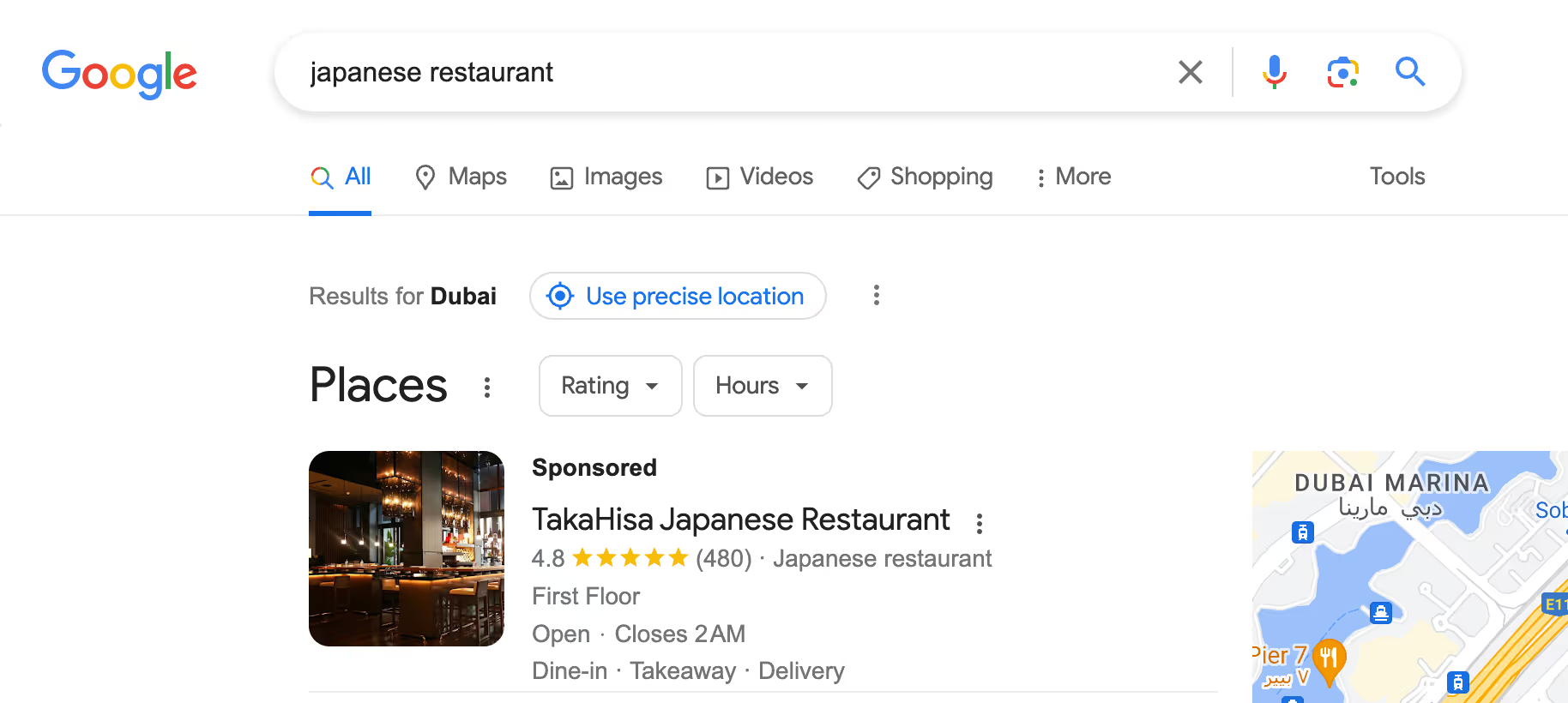
22. Give Back To The Community
Giving back to the community is a great way to boost reputation and awareness. Putting your successful restaurant at the service for the community builds a solid connection with your local customers.
Giving back can take the form of supporting charities, supporting someone in the community who’s going through a tough time, or by giving away your unsold items to shelters.

23. Conclusion
In a cutthroat industry, nailing your marketing is the key to standing out. Building a brand is like giving your restaurant a personality. Choose a color scheme that fits your vibe, whether it's family-friendly or student-centric. Build a website that’ll act as your digital storefront: make it inviting with easy navigation and mobile-friendliness. Don’t underestimate the power of well taken photos and instagrammable dishes. Leverage social media, influencers, and email marketing. From celebrating birthdays to throwing in sweet deals, it's all part of the marketing operation. Tapping into local events, using delivery apps, and maybe even having your own app are smart initiatives that will build both brand awareness and loyalty.
In a nutshell, there are numerous ways to market your restaurant, from digital ads to paper leaflets. The best strategy would be to try different mediums and see which one works best for you. Ultimately, finding your marketing strategy is about understanding your customers, their habits, and their behavior, and reaching out to them using the channels that will resonate the most with them.
24. About Supy
Supy is a data-driven restaurant inventory management software built to help multi-chain restaurants cut costs. Our recipe management software, inventory management software, menu engineering software, and the rest of our suite of products are built to enable the free flow of data throughout your back of house operations. This enables decision-makers to make informed decisions any time, from anywhere.
Related Resources




